|
|
 TELESCOPE MECHANICAL DESIGN TELESCOPE MECHANICAL DESIGN
 | POINTING THE TELESCOPE |
|
 |
|
| |
The telescope optics focus Cosmic Microwave Background radiation from the sky onto the detectors. In order to point the telescope at any place in the sky, the telescope needs to be able to spin around (this is the azimuth axis) and point from horizon to straight up (this is the elevation axis). Because the telescope is so large and heavy, it needs to be carefully engineered to keep it rigid as it is moved. The most important part is to keep the mirror rigid in exactly the right shape regardless of how the telescope is moved or positioned.
The primary mirror focuses CMB light waves to a point about 7 meters in front of the mirror. A large steel boom holds the instrumentation at that point. The instrument itself weighs more than a ton not including any or the electronics or cabling. Because the boom flexes a bit, the instrument is held on a platform that can be moved to make up for the flex. Motors are connected to the elevation and azimuth axes and can move the telescope quickly. The motors can also be commanded to set the position to an accuracy of the size of a quarter at the distance of a football field. During operation,the telescope scans back and forth across the sky and records the brightness as it goes. This data is used to make a large map showing the variation in brightness across the sky.
|
| |
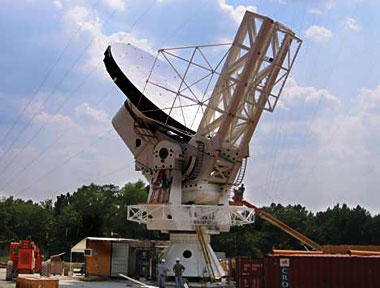 Testing the pointing of the telescope during the test assembly in Kilgore, Texas in Summer 2006. The secondary mirror cryostat and the detector cryostat have not been mounted but will go on the end of the large boom.
Testing the pointing of the telescope during the test assembly in Kilgore, Texas in Summer 2006. The secondary mirror cryostat and the detector cryostat have not been mounted but will go on the end of the large boom.
|
| |
 | THE PRIMARY MIRROR |
|
 |
|
| |
The primary mirror itself (also called the primary reflector) is made up of over 200 individual aluminum panels, each about 1 meter in size. They are mounted on a carbon fiber backing structure that is very light and stiff. Adjusting screws are used to align the panels so that they fit together to make the correct shape. The shape that the panels form must be set more accurately than the thickness of a human hair. A team of SPT scientists assembles the mirror by mounting each panel individually on the backing structure, and carefully aligning the panels using the adjusting screws. Several types of measurements are done to check the shape of the resulting mirror surface as it is being built, and afterwards to verify that the shape does not change as the telescope is moved to point in different directions.
|
| |
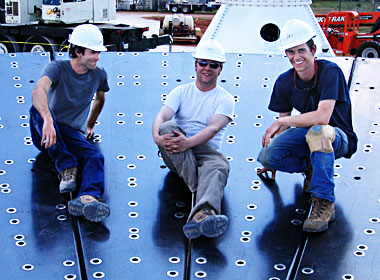 University of Chicago graduate student Joaquin Vieira, postdoctoral researcher Tom Crawford, and graduate student Ryan Kiesler sitting on the carbon fiber backing structure for the primary mirror, during a test-assembly in Summer 2006.
University of Chicago graduate student Joaquin Vieira, postdoctoral researcher Tom Crawford, and graduate student Ryan Kiesler sitting on the carbon fiber backing structure for the primary mirror, during a test-assembly in Summer 2006.
|
| |
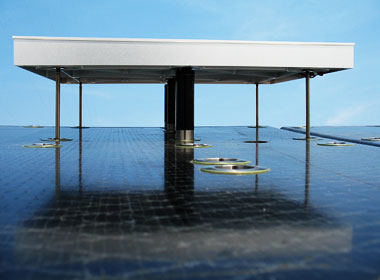 One of the individual mirror panels mounted on the backing structure.
One of the individual mirror panels mounted on the backing structure.
|
| |
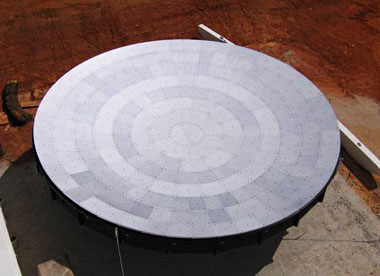 The completed primary mirror during the test build in Summer 2006.
The completed primary mirror during the test build in Summer 2006.
|
| |
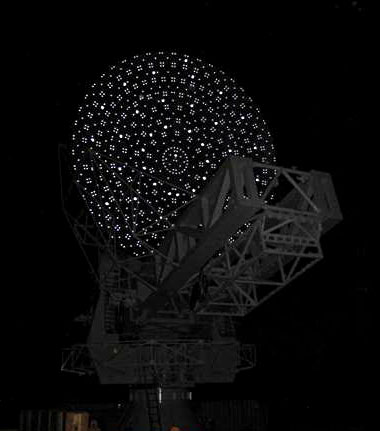 During the test build in Summer 2006, one of the goals was to verify that the mirror shape could be set correctly. This picture shows reflections off of small reflective stickers that are placed on each panel. Special photographic analysis allows the surface of the mirror to be measured.
During the test build in Summer 2006, one of the goals was to verify that the mirror shape could be set correctly. This picture shows reflections off of small reflective stickers that are placed on each panel. Special photographic analysis allows the surface of the mirror to be measured.
|
| |
|
|
 TELESCOPE MECHANICAL DESIGN
TELESCOPE MECHANICAL DESIGN